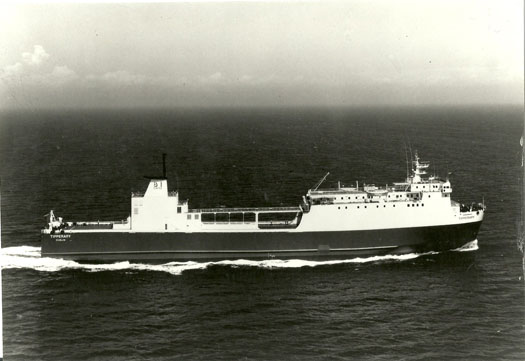Displaying items by tag: Afloat Calender Dates
B+I Line… ‘The Best of Irish’ Reunion Steams Ahead for Eden Quay, Dublin
#B+IlineReunion – A B+I Line reunion is to be held at the Clifton Court Hotel, Eden Quay, Dublin on Saturday November 15th starting at 20.00hrs, writes Jehan Ashmore.
The British and Irish Steam Packet Company otherwise commonly known as simply 'The B+I Line' was founded in 1836 and was later sold by Coast Lines Ltd to the Irish Government in 1965.
Former employees of the state-owned car ferry and freight operator, from crew members to shore-based personnel are all welcome to attend the annual reunion now in its fourth year.
The reunions over the previous years have been a great success and the organisers hope to see many more of friends and shipmates there this year. The gathering will bring no doubt many seafaring tales and antics from on and offshore too!
Among the company's most remembered marketing campaigns where... B+I Line 'Motorway' to advertise Irish Sea car ferry services and by sailing with an Irish crew hence the slogan 'B&I... The Best of Irish!
A subtle change in branding was the replacement of the company's abbreviated name from 'B+I Line' which dropped the 'plus' sign to that of the ampersand as the 'B&I Line' which appeared in more recent times of the operators existance.
The B&I Line operated a fleet of car-ferries named after provinces such as 'Leinster' while ro-ro freight-ferries and containerships were given the theme of towns and counties such as the 'Wicklow'. In addition Corkonians proudly had the the popular name of 'Innisfallen' that graced several ships serving across the Celtic Sea.

B+I Line's ro-ro freight ferry Tipperary. Photo: Jehan Ashmore Collection
B&I Line remained in state control for almost 50 years until sold in 1991 to private interests, Irish Continental Group (ICG), parent company of Irish Ferries. Despite the sale of the famous household name known on both sides of the Irish Sea, this name continued trading albeit as 'B&I Line – an Irish Ferries Company'.
The last vestiges of the venerable B&I Line name that spanned the past 160 years was eventually consigned to history when the transition took place on 1 January 1995 with that of the brand Irish Ferries.
For further information about the B&I Line reunion, contact Noel Byrne on: 086 313 0697 or email: [email protected] or Morris Ward on 087 740 9249
Community Arts Exhibition at Rosslare Harbour Maritime Heritage Centre
#Exhibition - The Rosslare Maritime Enthusiasts are hosting a Community Arts Exhibition at the Rosslare Harbour Maritime Heritage Centre which opened this October Bank Holiday weekend and will continue to Sunday 2 November.
The exhibition opening times are daily between 12 noon and 6pm which forms part of the Wexford Opera Festival Fringe Events.
The centre promotes the local maritime history of Wexford and nationally in addition to internationally.
For information about the centre and other events and activities, visit their facebook page here.
‘Open Day’ at the National Maritime College of Ireland
#OpenDay@NMCI – An 'Open Day' at the National Maritime College of Ireland (NMCI), Europe's only purpose built maritime education college which celebrated its 10th anniversary earlier this month, is to be held on Tuesday 21 October.
Times for the Open Day are 10am-3pm. Visitors can take tours to view the impressive facilities located at the campus in Ringsakiddy, Cork Harbour.
The world class maritime education and training centre at NMCI became the first third level college in the country to be built under the Government's Public-Private Partnership scheme.
NMCI is a constituent college of CIT and brings together the Irish Naval Service and Merchant Marine under one roof in one of the most advanced maritime academies of its type in the world.
For further information about the Open Day, enquiries and bookings for large groups contact NMCI Tel: (021) 433 5607 by email: [email protected] and for more visit the website: www.nmci.ie
Lecture: Going to Sea in the Sixties
#Lecture - Following the launch of the Maritime Institute of Ireland's autumn/winter lecture programme last month, the next lecture of the season is 'Going to Sea in the Sixties' and to be held on Thursday 16 October.
On this occasion the speaker is Captain Jim Kennedy, master mariner and former RNLI instructor. As usual the lectures start at 8pm and takes place in Dublin city centre at the Stella Maris Club, Beresfort Place beside Bus Aras.
Entry is by voluntary donation to help meet overheads of the M.I.I. which runs the National Maritime Museum (NMMI) in Dun Laoghaire. The lecture organisers would be pleased for anyone to kindly forward details about the lecture programme, held on the third Thursday of each month.
For information contact Barney Yourell, Lectures Officer of the Institute on 087 900 7466 or (01) 847 6118
Public transport: The nearest DART stations are Connolly Station and at Tara Street in addition to the LUAS (Red) line stop at Busáras. Car parking is located in the Irish Life Mall (ILAC) on Lower Abbey Street.
Information about the National Maritime Museum, which has a gift shop and café located in the former Mariners Church Dun Laoghaire, visit:www.mariner.ie
Maritime Institute of Ireland to Hold AGM
#MaritimeInstitute - The AGM of the Maritime Institute of Ireland, whose patron is President Michael D. Higgins, is to be held next Saturday 18 October in the institute's National Maritime Museum of Ireland, Dun Laoghaire.
Members of the M.I.I are invited to attend the AGM which starts at 12 noon. The museum located in the former Mariner's Church is where 14 of its parishioners were killed in World War I and this will be acknowledged during the meeting.
The museum which is open to members free of charge is also open to the public, where in addition to the many diverse and interesting exhibits on display, there is a library, souvenir gift shop and café.
In recent years the museum underwent a major refursbishment, for a 3D tour of the museum click HERE. To activate, click on map to launch 3D interactive viewing. For further information about the visitor attraction visit: www.mariner.ie
Maritime Institute Lectures Programme Returns
#Lectures- It's that time of the year again as the Maritime Institute of Ireland's Autumn/Winter lecture programme starts next week (Thursday 18 Sept).
The inaugural lecture of the season titled 'Rochsay Castle shipwreck-the Dublin Connection 1831' is to be presented by Seamus O Maitiu.
All lectures take place in Dublin city centre at the Stella Maris Club, Beresfort Place beside Bus Aras. Likewise all lectures commence at 8.00p.m. sharp and entry is by voluntary donation to help meet overheads of the M.I.I. which runs the National Maritime Museum (NMMI) in Dun Laoghaire.
The organisers would be pleased for anyone to kindly forward details about the lecture programme, which is held on the third Thursday of each month. For further information contact Barney Yourell, Lectures Officer of the Institute on 087 900 7466 or (01) 847 6118
Public transport: The nearest DART stations are Connolly Station and at Tara Street in addition to the LUAS (Red) line stop at Busáras. Car parking is located in the Irish Life Mall (ILAC) on Lower Abbey Street.
For further information about the National Maritime Museum, which has a gift shop and café located in the former Mariners Church Dun Laoghaire, visit: www.mariner.ie
National Heritage Week: Lecture Series 'The War to End All Wars'
#heritageweek- National Heritage Week which is in fact 9 days long, is at this stage nearing its half-way stage, yet there are still days left to discover and enjoy our heritage.
The annual event is co-ordinated by The Heritage Council and its aim is to build awareness and education about our heritage thereby encouraging its conservation and preservation.
Among the events previously posted on Afloat.ie is a reminder of the Maritime Institute of Ireland's (MII) lecture series titled 'The War to End All Wars'. This is to be held in the Eblana Club, Dun Laoghaire this Sunday 31 August, the final day of the Heritage Week.
The lecture series will feature 8 speakers throughout the day and accompanied by discussions, debates, music and song.
Among the lectures is 'Excusive New Material on the Mailboat Leinster Sinking' presented by Roy Stokes. This lecture includes a unique playing of an interview with Jim Sweeney, Second Purser on RMS Leinster.
Later that day a lecture 'With Regard to RMS Lusitania' by David Snook will no doubt provide much interest too.
The first lecture is 12 am and continues to 8 pm at the venue on Elana Avenue located off Marine Road. Registration begins as at 11.30 so make sure you book early as places are limited.
Programme details (in PDF format to download) are found on the M.I.I. website HERE. In addition this website provides further details of their National Maritime Museum of Ireland which is located nearby to the Eblana Club.
For ALL events held throughout the country and further details during National Heritage Week visit: www.heritageweek.ie
Father Ted's Ship: An Exhibition From Art to Rust
#FatherTedShip – To those shipping historians the wreck of the Plassy on Inisheer can be traced to her owners, the Limerick Steamship Company, while to many she is more familiar with her featuring in the opening credits of Father Ted.
What is not deniable between fact and fiction is the passage of time reflected on this shipwreck. The exhibition 'Art of Rust – From Rust to Art' opens in the National Maritime Museum of Ireland (NMMI) next Thursday on 12 June.
The museum invites you to the launch of the event between 5 to 7pm where you can discover new photos by Loïc Couzineau of the wreck of the Plassy. The show which runs to 17 August, unveil its mysteries and secrets of an amazing world full of surprises. For further details in general visit www.mariner.ie
So how did the Plassy get to be where she has been since 1960, with her back broken across grey boulders on the easternmost island of the Aran Islands.
It was during a passage through Galway Bay and a mixed cargo of stained glass, yarn and whiskey, when she was caught is a severe storm. The atrocious weather on 8 March led to her grounding onto Finnis Rock on the east side of the island.
All her crew were rescued from the stricken vessel by islanders using a breeches-buoy.
#ChoirFundraiser –Why not come along to the hear excellence from the Ballinteer Male Voice Choir and at the same time raise funds for the National Maritime Museum.
The fundraiser's two hour evening event (between 7.30 -9.30pm) on 22 May will be held in the apt surroundings of the museum in Dun Laoghaire, which was the former Mariners Church.
Founded 20 years ago, the Ballinteer Male Voice Choir has an international reputation and an eclectic programme of male voice classics among them Va Pensiero, The Gendarmes and the Bread of Heaven.
In addition the repertoire has such modern music such as Bridge over Troubled Waters, She was Beautiful as well as Irish Songs arranged by director Ray Ryan and accompanist is Graham Walsh.
Tickets to assist funding the museum are €10 and payable at the door or may be pre-booked at [email protected] or tel: (01) 214 3964
For further details in general about the NMMI visit: www.mariner.ie
#ShippingPosters – Sail Away: Liverpool Shipping Posters, a brand new exhibition is to displayed at the Merseyside Maritime Museum a month from today on 16 May.
The exhibition explores a century of shipping posters from the Merseyside Maritime Museum's collection featuring 14 posters dating between 1888 to 1980 , advertising many Liverpool shipping companies and many of which have never been on display before. It features posters advertising emigrant services, right through to the age of luxury transatlantic liners.
Liverpool Shipping Posters illustrate for example the era of glamorous passengers on the deck of a ship, used for advertising 'Bibby Line short sea cruises'. This particular poster to publicise the exhibition is used with the kind permission from the Archive Department of Bibby Line Group Limited in Liverpool.
For more about the poster exhibition and other events currently on show visit: www.liverpoolmuseums.org.uk/maritime/events/






































































